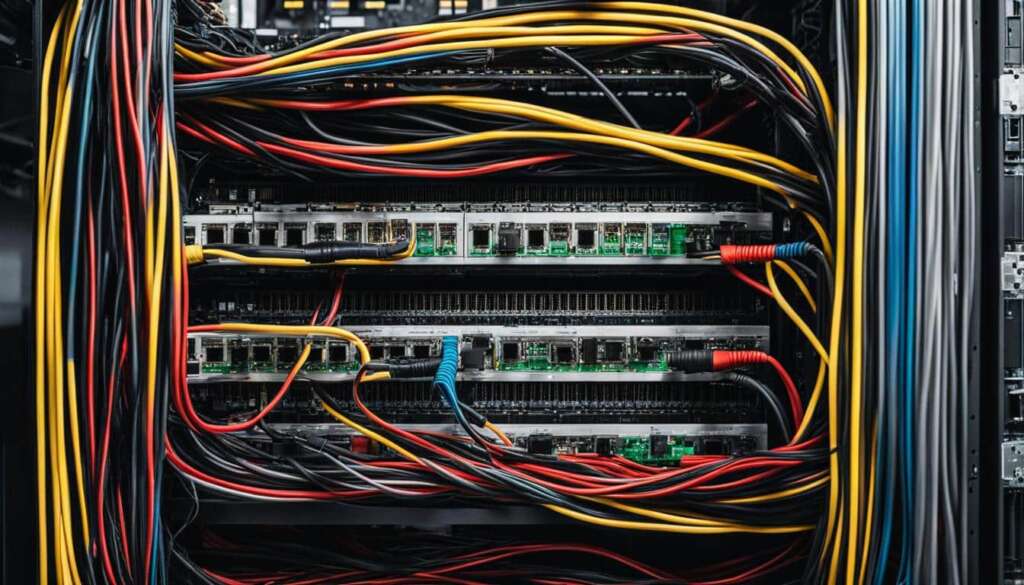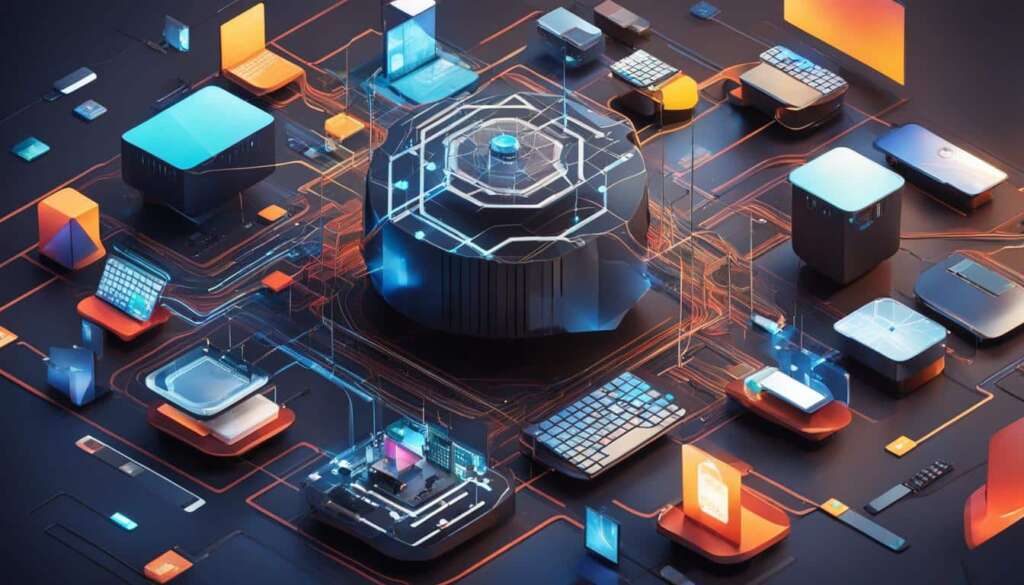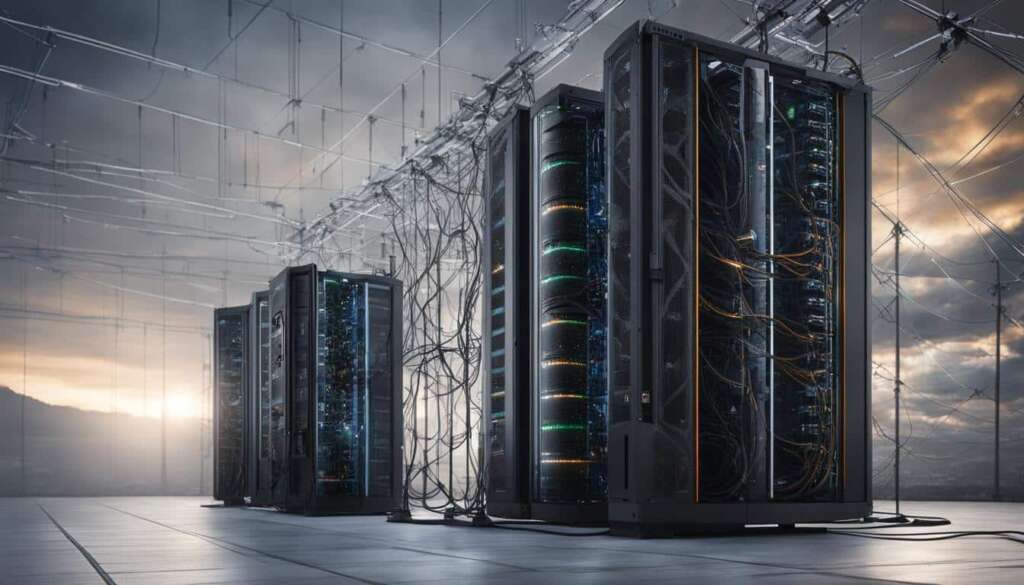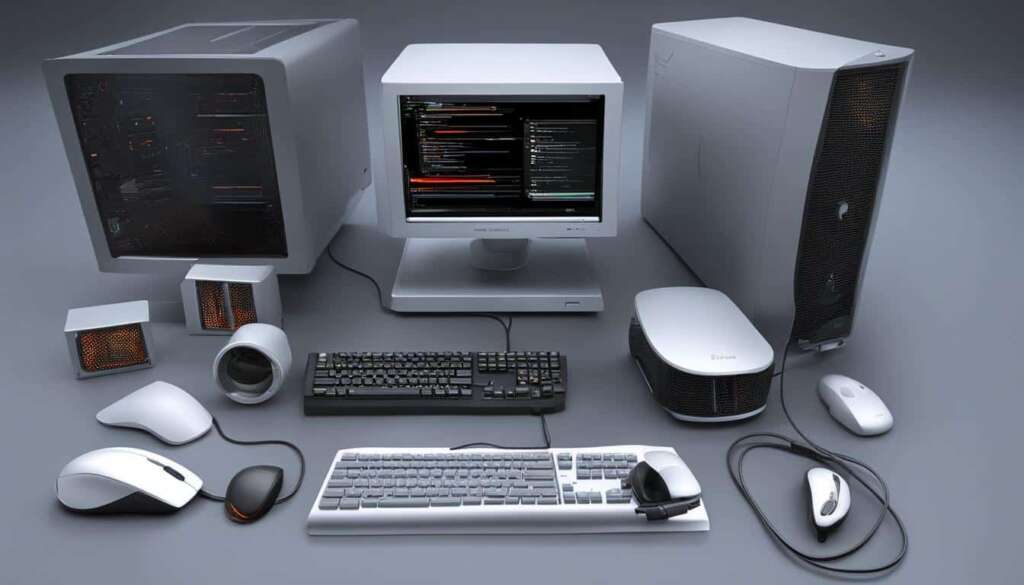Table of Contents
Welcome to the digital era, where connectivity reigns supreme and drives progress in every aspect of our lives. In this interconnected world, servers play a pivotal role in facilitating seamless communication, data exchange, and resource sharing. To harness the true potential of connectivity, it is crucial to understand the definition and meaning of a server.
So, what exactly is a server? Think of it as the central powerhouse that enables the flow of information and services across networks. It acts as a hub, storing, managing, and delivering data to connected devices and users. From websites to cloud computing and beyond, servers are the backbone of modern technology.
But why is this understanding so important?
By grasping the essence of a server, you unlock a world of possibilities. Whether you’re a business looking to optimize productivity or an individual seeking secure online experiences, servers hold the key to success. With their versatile functionality and robust capabilities, servers empower you to conquer the digital realm.
So, let’s embark on a journey to explore the intricacies of servers, their various types, essential functions, incredible benefits, widespread applications, critical components, and the vital role played by server providers. Together, we will delve deep into the realm of servers and reveal the true power of connectivity.
But first, let’s have a visual glimpse of this remarkable technology:
Types of Servers
Servers come in various types, each serving specific functions and catering to different needs. Understanding the different types of servers can help you choose the right one for your specific requirements.
1. File Server
A file server is primarily responsible for storing and sharing files across a network. It acts as a centralized location where users can access, retrieve, and modify files, promoting collaboration and efficient file management.
2. Web Server
A web server is designed to deliver web pages and web applications to users. It hosts websites and handles requests from web browsers, ensuring the smooth and secure delivery of content over the internet.
3. Database Server
A database server manages, stores, and retrieves data from databases. It allows multiple users to access and work with the same database simultaneously, ensuring data integrity and efficient data management.
4. Application Server
An application server is responsible for hosting and executing applications and services. It provides a runtime environment for applications, handling tasks such as session management, load balancing, and scalability.
5. Mail Server
A mail server handles the sending, receiving, and storage of emails. It enables users to access their email accounts and facilitates the efficient exchange of electronic messages.
6. Print Server
A print server manages and controls printers within a network. It allows users to send print jobs to specific printers, ensuring efficient use of resources and centralized printer management.
| Server Type | Main Function | Examples |
|---|---|---|
| File Server | Store and share files | Windows File Server, Dropbox |
| Web Server | Deliver web pages and applications | Apache HTTP Server, Microsoft IIS |
| Database Server | Manage and retrieve data from databases | MySQL, Oracle Database |
| Application Server | Host and execute applications and services | Java Application Server, Microsoft Azure |
| Mail Server | Handle email sending, receiving, and storage | Microsoft Exchange Server, Postfix |
| Print Server | Manage and control printers | CUPS, Windows Print Server |
Functions of a Server
Servers play a vital role in ensuring the smooth operation of networks and the efficient delivery of services. They perform a range of essential functions that enable seamless communication, data management, and resource sharing. Let’s explore some of the key functions of a server:
1. Data Storage and Management
A server acts as a centralized storage facility, providing a secure and scalable platform for data storage and management. It allows organizations to store vast amounts of data in a structured manner, ensuring easy access, retrieval, and backup.
2. Data Sharing and Collaboration
By facilitating data sharing and collaboration, servers enable seamless communication and efficient teamwork. They allow multiple users to access and modify shared files and documents simultaneously, fostering real-time collaboration and enhancing productivity.
3. Application Hosting
Servers can host various applications, enabling users to access them remotely. This functionality enables businesses to centralize application management, ensuring consistent accessibility and efficient updates. It also allows for better control and security of critical business applications.
4. User Authentication and Access Control
Servers support user authentication and access control mechanisms, ensuring secure access to resources and protecting sensitive data. By enforcing user permissions and authentication protocols, servers prevent unauthorized access and safeguard critical information.
5. Network Management
Servers have built-in tools and functionalities that enable effective network management. They provide centralized control over network resources, monitoring network performance, and troubleshooting issues. This helps IT administrators to optimize network efficiency and ensure a smooth user experience.
These are just a few examples of the crucial functions servers perform. Their versatility and ability to handle multiple tasks make servers an indispensable component of modern network infrastructure.
<!–
–>
Benefits of Using a Server
Unlock the full potential of connectivity by utilizing a server. Not only does it facilitate seamless communication and data exchange, but it also offers a multitude of benefits that can significantly enhance productivity, efficiency, and security in various environments.
One of the key benefits of using a server is the centralized storage and management of data. With a server, you can easily store and access all your files in one secure location. This eliminates the need to store data on individual devices, reducing the risk of data loss and ensuring that important information is readily available to authorized users.
Additionally, a server enables efficient resource sharing. By connecting multiple devices to a server, you can easily share files, applications, and hardware resources, such as printers and scanners. This promotes collaboration and streamlines workflows, saving time and effort for your team.
A server also enhances data security. With robust security measures in place, such as firewalls, encryption, and access controls, a server helps safeguard sensitive information from unauthorized access. This is especially crucial for businesses handling confidential data or complying with data protection regulations.
Furthermore, using a server enhances scalability and flexibility. As your business grows, a server can easily accommodate increasing data storage and processing requirements. You can also customize and scale server resources to meet specific needs, ensuring optimal performance and cost-effectiveness.
Lastly, a server improves backup and disaster recovery capabilities. By regularly backing up data to a server, you can protect against data loss due to hardware failures, human error, or natural disasters. In the event of a system failure, you can quickly restore data from backups, minimizing downtime and business disruption.
To visualize the benefits of using a server, refer to the table below:
| Benefits |
|---|
| Centralized data storage and management |
| Efficient resource sharing |
| Enhanced data security |
| Scalability and flexibility |
| Improved backup and disaster recovery |

By harnessing the benefits provided by a server, businesses and individuals can optimize their operations, boost collaboration, and ensure the security of their valuable data. The next section will explore the wide range of usage and applications for servers.
Server Usage and Applications
With their versatile capabilities, servers find extensive usage in a myriad of industries and applications. Organizations across the globe rely on servers to power their digital infrastructure and support a wide range of operations. Some common use cases for servers include:
Data Storage and Retrieval
One of the primary functions of a server is to store and manage vast amounts of data. Whether it’s customer information, financial records, or media files, servers provide a secure and centralized storage solution. In addition, servers allow for efficient retrieval of data, ensuring quick and reliable access when needed.
Website Hosting
For businesses and individuals looking to establish an online presence, servers play a key role in hosting websites. By storing website files and databases, servers enable websites to be accessible to users around the clock. With robust server infrastructure, websites can handle high traffic volumes and deliver a seamless user experience.
Email and Messaging Services
Servers also facilitate the smooth and secure exchange of electronic communications. Email servers, for example, enable the sending, receiving, and storage of emails. Messaging servers, on the other hand, power instant messaging platforms, allowing for real-time conversations and collaboration.
Application Hosting and Deployment
Many applications and software solutions require a server environment to function properly. Servers provide the necessary infrastructure for hosting and deploying applications, ensuring optimal performance and accessibility. This allows businesses and developers to deliver their software products to end-users efficiently.
Virtualization
Servers are integral to virtualization technology, which enables the creation of multiple virtual machines on a single physical server. This allows for more efficient use of resources, cost savings, and simplified management of complex IT environments. Virtualization is commonly used for cloud computing, software testing, and server consolidation.
Database Management
With their robust processing power, servers are ideal for managing relational databases. They provide the necessary computing resources to store, organize, and process large amounts of structured data. Database servers support critical business operations such as inventory management, customer relationship management (CRM), and financial analysis.
These are just a few examples of how servers are utilized across various industries. As technology continues to advance, the applications of servers will only continue to expand, ensuring the seamless flow of data, services, and communication in our increasingly interconnected world.
Server Components and Setup
Servers consist of various components that work together to provide their functionalities. Understanding these server components and the setup process is essential for optimizing server performance and ensuring smooth operations.
Some key components of a server include:
- Processor (CPU): The processor acts as the brain of the server, executing instructions and performing calculations to process data quickly and efficiently.
- Memory (RAM): Server memory allows for the storage and retrieval of data, ensuring faster response times and smoother multitasking.
- Storage: Servers require storage for storing data, applications, and operating systems. This can be in the form of hard disk drives (HDDs), solid-state drives (SSDs), or even network-attached storage (NAS) devices.
- Network Interface Card (NIC): The NIC enables the server to connect and communicate with other devices and networks, facilitating data transfer and network connectivity.
- Power Supply Unit (PSU): The PSU supplies power to the server components, ensuring uninterrupted operation.
- Motherboard: The motherboard acts as a central circuit board that connects and allows communication between various server components.
- Cooling System: Servers generate a significant amount of heat, and a cooling system, including fans or liquid cooling, keeps the server components at optimal temperatures.
Setting up a server requires careful planning and configuration. The server setup process typically involves:
- Choosing the right hardware components based on the intended use and performance requirements.
- Installing the operating system (OS) suitable for the server’s needs, such as Windows Server or Linux distributions like Ubuntu Server or CentOS.
- Configuring network settings and ensuring connectivity.
- Installing and configuring server software, including applications, databases, and security measures.
- Optimizing server settings and performance through fine-tuning, load balancing, and security configurations.
By understanding the server components and efficiently setting up servers, businesses and individuals can ensure reliable performance, enhanced security, and efficient data management.
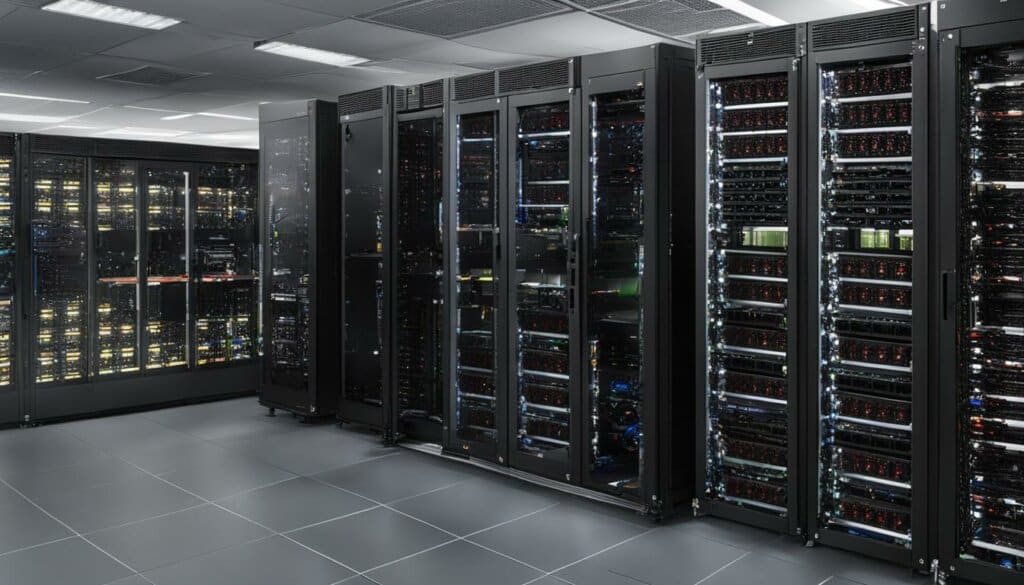
The Role of a Server Provider
Server providers play a crucial role in delivering reliable and efficient server solutions. They offer a range of services, including:
- Server setup and configuration: A server provider takes care of the initial setup and configuration of the server, ensuring that it is optimized for performance and security. They handle the technical aspects, allowing businesses to focus on their core operations.
- Server maintenance and monitoring: To ensure smooth and uninterrupted operations, server providers offer maintenance and monitoring services. They perform regular updates, security patches, backups, and monitoring to detect and address any potential issues promptly.
- Data backup and recovery: Server providers implement robust backup and recovery solutions to safeguard valuable data. In the event of data loss or system failure, they can restore the server to its previous state, minimizing downtime and potential losses.
- Scalability and resource management: As businesses grow, their server requirements may change. Server providers facilitate scalability by offering flexible plans and resources, allowing businesses to easily upgrade or downsize their server capacity as needed.
- Security and compliance: Server providers prioritize security and ensure compliance with industry standards and regulations. They implement robust security measures, such as firewalls, encryption, and access controls, to protect sensitive data from unauthorized access and malicious threats.
- 24/7 technical support: Reliable server providers offer round-the-clock technical support to address any issues or concerns that may arise. Their experienced support teams are available to provide assistance and resolve any server-related issues promptly.
By partnering with a reputable server provider, businesses can offload the complex and time-consuming task of managing servers, allowing them to focus on their core competencies and achieve optimal performance and efficiency.
| Advantages | Disadvantages |
|---|---|
| Reliable and consistent server performance | Dependency on the server provider for updates and maintenance |
| 24/7 technical support and assistance | Potential limitations on customization and control |
| Frequent backups and robust data security measures | Ongoing costs for server maintenance and services |
| Scalability options to accommodate business growth | Potential risks associated with relying on a third-party provider |
Conclusion
Servers are the backbone of modern connectivity, providing a seamless platform for communication, data exchange, and resource sharing. By understanding the definition, types, functions, and benefits of servers, individuals and businesses can fully utilize the power of connectivity.
The versatility of servers allows them to be employed across various industries and applications, enabling organizations to optimize their online presence, foster collaboration, and ensure the security and scalability of their operations.
Choosing a reliable server provider is crucial in delivering efficient and secure solutions to meet the evolving demands of the digital world. By partnering with reputable server providers, businesses and individuals can enhance their server capabilities and stay ahead in today’s fast-paced digital landscape.
FAQ
What is a server?
A server is a fundamental component of modern communication and data exchange. It acts as a central hub that stores, manages, and delivers data and services across a network.
What are the types of servers?
Servers come in various types, each serving specific functions and catering to different needs.
What functions does a server perform?
Servers perform various functions that are critical to the smooth operation of networks and the delivery of services.
What are the benefits of using a server?
Utilizing a server offers several benefits that contribute to enhanced productivity, efficiency, and security in various environments.
In what applications can servers be used?
Servers find extensive usage in various industries and applications.
What are the components of a server?
Servers consist of various components that work together to provide their functionalities.
What is the role of a server provider?
Server providers play a crucial role in delivering reliable and efficient server solutions.

